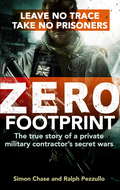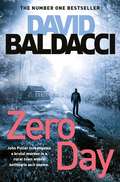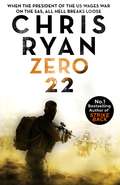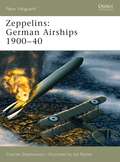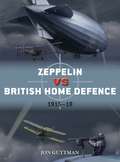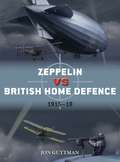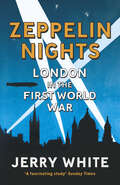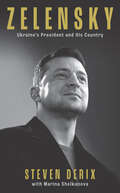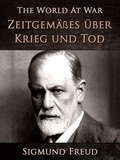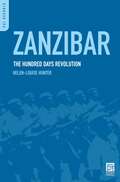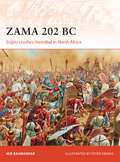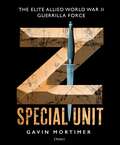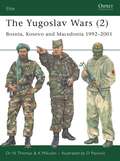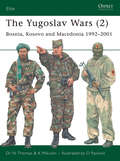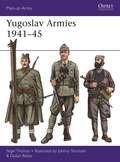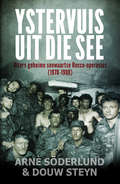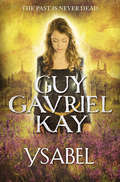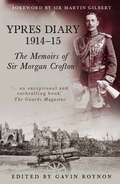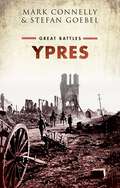- Table View
- List View
Zero Footprint: The true story of a private military contractor’s secret wars in the world’s most dangerous places
by Simon ChaseSimon Chase's life is a maze of burner phones, encrypted emails, secret meetings, and weaponry - all devoted to executing missions too sensitive for government acknowledgement. Working for shadowy British and American organisations, Chase has been on the trail of Bin Laden in Afghanistan, protected allied generals in Iraq, and been part of an operation directly related to the attack in 2012 on the US consulate in Benghazi.Zero Footprint takes us to this dangerous and thrilling world, and tells the true story of a private military contractor whose work forms the foundation for western security abroad, especially when the UK and US military, intelligence agencies, and departments of state need something done that they can't - or won't - do themselves.
Zero Day (John Puller series #1)
by David BaldacciZero Day is the explosive first instalment in David Baldacci's thrilling John Puller series. Distinguished as a top investigator in the US government, John Puller is called in to conduct an enquiry into the brutal murders of a family in a remote area of West Virginia. It soon becomes clear that the case has wider implications and as the body count rises he teams up with local homicide detective Samantha Cole. As the web of deceit is revealed, it quickly becomes apparent that there's much more to this case than they had first thought. It is an investigation where nothing is as it seems, and nothing can be taken at face value. When Puller and Cole discover a dangerous situation in the making, Puller finds he must turn to the one person who can help avert certain catastrophe. A person he has known all his life. In a breathtaking rollercoaster race against time, Cole fears for the community in which she was raised, and Puller knows he has to overcome the enemies of his country to avoid far reaching disaster. But in the end, you can't kill what you can't see is coming . . .
Zero 22
by Chris RyanAn SAS unit codenamed Zero 22, operating covertly in the war-torn badlands of northern Syria, is ambushed and massacred by a small army of mercenaries dressed like Hell's AngelsDanny Black survives the massacre and back in London learns that his unit was betrayed by a mole feeding high-level military intelligence to the Russians. Like any SAS man worthy of the name, his first thought is to avenge the men who lost their lives on the Zero 22 op.He has no hesitation in accepting the mission to assassinate the man responsible for the death of his mates. Danny finds himself operating with an MI6 officer and together they embark on a high-risk, deniable mission that will require all Danny's Regiment.As the mission unfolds, however, Danny learns that darker forces are at play. He realises that what started out as a simple act of revenge is just single play in a conspiracy that will take him across continents and pit him against the insidious machinations of the most powerful men in the world.
Zerborstene Texte und Wirklichkeiten in der Schwebe: Experimentelles Erzählen über den Nationalsozialismus (1990–2010) (Kontemporär. Schriften zur deutschsprachigen Gegenwartsliteratur #13)
by Daniela HenkeExperimentelle Texte über Holocaust und Nationalsozialismus fallen durch ein Forschungsraster. Durch ihre sperrige Form entziehen sie sich den Kategorien der memory studies – wegen ihrer brisanten Thematik sind sie ungeeignet für das rein formale Erkenntnisinteresse der klassischen Narratologie. Getragen von der Idee, dass Erzählformen selbst erzählen, verfolgt diese Untersuchung zwei Ziele. Zunächst wird eine allgemeine Typologie experimentellen Erzählens entworfen. Darauf folgen Analysen von Erzähltexten der Gegenwartsliteratur: Heldenfriedhof von Thomas Harlan, Morbus Kitahara von Christoph Ransmayr, Nahe Jedenew von Kevin Vennemann, Harlem Holocaust von Maxim Biller und Frühling von Thomas Lehr. Im Mittelpunkt stehen dabei die Funktionen experimentellen Erzählens mit Blick auf den ‚Undarstellbarkeitstopos‘ in seinen verschiedenen Variationen.
Zeppelins: German Airships 1900–40 (New Vanguard)
by Ian Palmer Charles StephensonOn 2 July 1900 the people of Friedrichshafen, Germany, witnessed a momentous occasion the first flight of LZ 1, Count Ferdinand von Zeppelin's first airship. Although deemed a failure, a succession of better craft (LZ2 to 10) enabled the Zeppelin to expand into the consumer market of airship travel, whilst also providing military craft for the German Army and Navy. The years of the Great War saw the Zeppelins undertake strategic bombing missions against Great Britain. This title covers the post-war fate of the Zeppelins, including the crash of the Hindenburg, and their use by the Luftwaffe at the beginning of World War II.
Zeppelins: German Airships 1900–40 (New Vanguard #101)
by Charles Stephenson Mr Ian PalmerOn 2 July 1900 the people of Friedrichshafen, Germany, witnessed a momentous occasion the first flight of LZ 1, Count Ferdinand von Zeppelin's first airship. Although deemed a failure, a succession of better craft (LZ2 to 10) enabled the Zeppelin to expand into the consumer market of airship travel, whilst also providing military craft for the German Army and Navy. The years of the Great War saw the Zeppelins undertake strategic bombing missions against Great Britain. This title covers the post-war fate of the Zeppelins, including the crash of the Hindenburg, and their use by the Luftwaffe at the beginning of World War II.
Zeppelin vs British Home Defence 1915–18 (Duel)
by Jim Laurier Jon GuttmanWhen Ferdinand Graf von Zeppelin's rigid airship LZ 1 flew over Lake Constance in 1900, it was the most advanced and impressive flying machine in the world: a colossal, lighter-than-air craft capable of controlled flight. In World War I, Zeppelins were first used in a reconnaissance role, but on 19 January 1915 Kaiser Wilhelm II authorised their use in bombing strategic targets in England. From then on, 'Zeppelin' became synonymous with terror to the British, and indeed the airship's effectiveness was more psychological than material. Still, their raids compelled the Royal Flying Corps and Royal Naval Air Service to embark on a program of modernising their aerial defences, accelerating a process that would ultimately make the aeroplane, rather than the airship, the paramount flying machine of the war. Using specially commissioned artwork, contemporary photographs and first-hand accounts, this book tells the fascinating story of Britain's first Blitz, from the airships who terrorised the public to the men who sought to defend the skies.
Zeppelin vs British Home Defence 1915–18 (Duel #85)
by Jim Laurier Jon GuttmanWhen Ferdinand Graf von Zeppelin's rigid airship LZ 1 flew over Lake Constance in 1900, it was the most advanced and impressive flying machine in the world: a colossal, lighter-than-air craft capable of controlled flight. In World War I, Zeppelins were first used in a reconnaissance role, but on 19 January 1915 Kaiser Wilhelm II authorised their use in bombing strategic targets in England. From then on, 'Zeppelin' became synonymous with terror to the British, and indeed the airship's effectiveness was more psychological than material. Still, their raids compelled the Royal Flying Corps and Royal Naval Air Service to embark on a program of modernising their aerial defences, accelerating a process that would ultimately make the aeroplane, rather than the airship, the paramount flying machine of the war. Using specially commissioned artwork, contemporary photographs and first-hand accounts, this book tells the fascinating story of Britain's first Blitz, from the airships who terrorised the public to the men who sought to defend the skies.
Zeppelin Nights: London in the First World War
by Jerry WhiteA Guardian Best Book of the Year 201411pm, Tuesday 4 August 1914: with the declaration of war London becomes one of the greatest killing machines in human history. Hundreds of thousands of soldiers pass through the capital on their way to the front; wounded men are brought back to be treated in London’s hospitals; and millions of shells are produced in its factories. The war changes London life for ever. Women escape the drudgery of domestic service to work as munitionettes. Full employment puts money into the pockets of the London poor for the first time. Self-appointed moral guardians seize the chance to clamp down on drink, frivolous entertainment and licentious behaviour. As the war drags on, gloom often descends on the capital. And at night London is plunged into darkness for fear of German bombers and Zeppelins that continue to raid the city. Yet despite daily casualty lists, food shortages and enemy bombing, Londoners are determined to get on with their lives and flock to cinemas and theatres, dance halls and shebeens, firmly resolved not to let Germans or puritans spoil their enjoyment. Peopled with patriots and pacifists, clergymen and thieves, bluestockings and prostitutes, Jerry White’s magnificent panorama reveals a struggling yet flourishing city.
Zen War Stories (Routledge Critical Studies in Buddhism)
by Brian VictoriaFollowing the critically acclaimed Zen at War (1997), Brian Victoria explores the intimate relationship between Japanese institutional Buddhism and militarism during the Second World War.Victoria reveals for the first time, through examination of the wartime writings of the Japanese military itself, that the Zen school's view of life and death was deliberately incorporated into the military's programme of 'spiritual education' in order to develop a fanatical military spirit in both soldiers and civilians. Furthermore, that D. T. Suzuki, the most famous exponent of Zen in the West, is shown to have been a wartime proponent of this Zen-inspired viewpoint which enabled Japanese soldiers to leave for the battlefield already resigned to death. Victoria takes us onto the naval battlefield in the company of warrior-monk and Rinzai Zen Master Nakajima Genjô. We view the war in China through the eyes of a Buddhist military chaplain. The book also examines the relationship to Buddhism of Japan's seven Class-A war criminals who were hung by the Tokyo War Crimes Tribunal in 1948.A highly controversial study, this book will be of interest, first and foremost, to students of Zen as well as all those studying the history of this period, not to mention anyone concerned with the perennial question of the 'proper' relationship between religion and the state.
Zen War Stories (Routledge Critical Studies in Buddhism)
by Brian VictoriaFollowing the critically acclaimed Zen at War (1997), Brian Victoria explores the intimate relationship between Japanese institutional Buddhism and militarism during the Second World War.Victoria reveals for the first time, through examination of the wartime writings of the Japanese military itself, that the Zen school's view of life and death was deliberately incorporated into the military's programme of 'spiritual education' in order to develop a fanatical military spirit in both soldiers and civilians. Furthermore, that D. T. Suzuki, the most famous exponent of Zen in the West, is shown to have been a wartime proponent of this Zen-inspired viewpoint which enabled Japanese soldiers to leave for the battlefield already resigned to death. Victoria takes us onto the naval battlefield in the company of warrior-monk and Rinzai Zen Master Nakajima Genjô. We view the war in China through the eyes of a Buddhist military chaplain. The book also examines the relationship to Buddhism of Japan's seven Class-A war criminals who were hung by the Tokyo War Crimes Tribunal in 1948.A highly controversial study, this book will be of interest, first and foremost, to students of Zen as well as all those studying the history of this period, not to mention anyone concerned with the perennial question of the 'proper' relationship between religion and the state.
Zelensky: Ukraine's President and His Country
by Steven DerixFirst major biography of Ukraine’s leader written for a Western audience Topical, up-to-date covering the Russian invasion of Ukraine 'Start here' book for those interested in the Ukraine war and inspirational leadership
Zeitgemäßes über Krieg und Tod (The World At War)
by Sigmund FreudAus dem Vorwort: “Von dem Wirbel dieser Kriegszeit gepackt, einseitig unterrichtet, ohne Distanz von den großen Veränderungen, die sich bereits vollzogen haben oder zu vollziehen beginnen, und ohne Witterung der sich gestaltenden Zukunft, werden wir selbst irre an der Bedeutung der Eindrücke, die sich uns aufdrängen, und an dem Wert der Urteile, die wir bilden. Es will uns scheinen, als hätte noch niemals ein Ereignis soviel kostbares Gemeingut der Menschheit zerstört, so viele der klarsten Intelligenzen verwirrt, so gründlich das Hohe erniedrigt.”
Zanzibar: The Hundred Days Revolution (PSI Reports)
by Helen-Louise HunterIn the late 1950s, Communists decided that Zanzibar offered them a particular favorable opportunity for expanding their influence.
Zama 202 BC: Scipio crushes Hannibal in North Africa (Campaign)
by Peter Dennis Mir BahmanyarThe battle of Zama, fought across North Africa around 202 BC, was the final large-scale clash of arms between the world's two greatest western powers of the time – Carthage and Rome. The engagement ended the Second Punic War, waged from 218 until 201 BC. The armies were led by two of the most famous commanders of all time – the legendary Carthaginian general Hannibal, renowned for crossing the Alps with his army into Italy, and the Roman general Publius Cornelius Scipio, who along with his father was among the defeated at the battle of Cannae in 216 BC.Drawing upon years of research, author Mir Bahmanyar gives a detailed account of this closing battle, analysing the tactics employed by each general and the forces they had at their disposal. Stunning, specially commissioned artwork brings to life the epic clash that saw Hannibal defeated and Rome claim its spot as the principal Mediterranean power.
Zama 202 BC: Scipio crushes Hannibal in North Africa (Campaign)
by Peter Dennis Mir BahmanyarThe battle of Zama, fought across North Africa around 202 BC, was the final large-scale clash of arms between the world's two greatest western powers of the time – Carthage and Rome. The engagement ended the Second Punic War, waged from 218 until 201 BC. The armies were led by two of the most famous commanders of all time – the legendary Carthaginian general Hannibal, renowned for crossing the Alps with his army into Italy, and the Roman general Publius Cornelius Scipio, who along with his father was among the defeated at the battle of Cannae in 216 BC.Drawing upon years of research, author Mir Bahmanyar gives a detailed account of this closing battle, analysing the tactics employed by each general and the forces they had at their disposal. Stunning, specially commissioned artwork brings to life the epic clash that saw Hannibal defeated and Rome claim its spot as the principal Mediterranean power.
Z Special Unit: The Elite Allied World War II Guerrilla Force
by Gavin MortimerLeading expert Gavin Mortimer tells the remarkable origin story of a wartime special forces unit that defied the odds.Z Special Unit, one of the most intrepid but arguably the most unsung of Allied Special Forces of the Second World War waged a guerrilla war against Japan for two years in the south-west Pacific. On some of their 81 operations Z Special Unit slipped into enemy harbours in canoes and silently mined ships before vanishing into the night; on others they parachuted into the dense Borneo jungle to fight with headhunters against the Japanese and on one occasion they landed on an Indonesian island and smuggled out the pro-Allied sultan from under Japanese noses. The Japanese weren't the only adversary that Z Special Unit encountered in the brutal terrain of the Pacific. In the mango swamps of Borneo and the dense jungle of Papua New Guinea they were faced with venomous snakes, man-eating crocodiles and deadly diseases. But it was the enemy soldiers who proved the most ruthless foe, beheading those Z Special Unit commandos who fell into their hands.Drawing on veteran interviews as well as operational reports and recently declassified SOE files, Gavin Mortimer explores the incredible history of this remarkable special forces unit and the band of commandoes that defied the odds.
Z Special Unit: The Elite Allied World War II Guerrilla Force
by Gavin MortimerLeading expert Gavin Mortimer tells the remarkable origin story of a wartime special forces unit that defied the odds.Z Special Unit, one of the most intrepid but arguably the most unsung of Allied Special Forces of the Second World War waged a guerrilla war against Japan for two years in the south-west Pacific. On some of their 81 operations Z Special Unit slipped into enemy harbours in canoes and silently mined ships before vanishing into the night; on others they parachuted into the dense Borneo jungle to fight with headhunters against the Japanese and on one occasion they landed on an Indonesian island and smuggled out the pro-Allied sultan from under Japanese noses. The Japanese weren't the only adversary that Z Special Unit encountered in the brutal terrain of the Pacific. In the mango swamps of Borneo and the dense jungle of Papua New Guinea they were faced with venomous snakes, man-eating crocodiles and deadly diseases. But it was the enemy soldiers who proved the most ruthless foe, beheading those Z Special Unit commandos who fell into their hands.Drawing on veteran interviews as well as operational reports and recently declassified SOE files, Gavin Mortimer explores the incredible history of this remarkable special forces unit and the band of commandoes that defied the odds.
The Yugoslav Wars: Bosnia, Kosovo and Macedonia 1992–2001 (Elite)
by Nigel Thomas Darko Pavlovic K MikulanFollowing the death of the Yugoslavian President Tito in 1980, the semi-autonomous republics and provinces that he had welded into a multi-cultural nation in 1945 slid gradually towards separation. For ten years following 1991, the world watched in horror as a series of bloody wars ripped a modern European state apart, and the intolerable spectacle eventually forced international intervention. Illustrated with rare photos and colour uniform plates, this second of two volumes by experts on the Balkan region offers a concise breakdown of the indigenous forces involved in Bosnia-Herzegovina, Kosovo and Macedonia.
The Yugoslav Wars: Bosnia, Kosovo and Macedonia 1992–2001 (Elite #146)
by Nigel Thomas Darko Pavlovic K MikulanFollowing the death of the Yugoslavian President Tito in 1980, the semi-autonomous republics and provinces that he had welded into a multi-cultural nation in 1945 slid gradually towards separation. For ten years following 1991, the world watched in horror as a series of bloody wars ripped a modern European state apart, and the intolerable spectacle eventually forced international intervention. Illustrated with rare photos and colour uniform plates, this second of two volumes by experts on the Balkan region offers a concise breakdown of the indigenous forces involved in Bosnia-Herzegovina, Kosovo and Macedonia.
Yugoslav Armies 1941–45 (Men-at-Arms)
by Nigel Thomas Dusan BabacIn March 1941, an anti-German coup in the Kingdom of Yugoslavia prompted Hitler to order an invasion using allied Italian, Hungarian, Bulgarian and Romanian forces. Operation Marita was an invasion of Yugoslavia and simultaneously Greece. At the same time, the constituent region of Croatia broke away from Yugoslavia and joined the Axis powers. Royal Yugoslav armed forces, despite advancing against the Italians in Albania were forced to surrender after 11 days' fighting and some 1,000 soldiers, airmen and sailors escaped to British-occupied Egypt to form Free Yugoslav units. From there, guerrilla resistance to the Axis occupiers broke out and continued with increasing strength until the end of the war under Mihailovic's royalist 'Chetniks' and Tito's Communist 'Partisans' (both supported by Britain). However, hostilities between the two movements eventually led to the Chetniks entering into local agreements with Italian occupation forces and Britain switching its support entirely to the Partisans. The advance of the Red Army increased Partisan strength and, during 1944–45, they created what could be described as a lightly equipped conventional army.Using meticulously-drawn illustrations of different insignia, uniforms and equipment from each faction to bring the conflict alive, this volume describes, in detail, both the political and military implications of the war and how it was fought, setting the scene for the subsequent rise of Tito to power within Yugoslavia.
Ystervuis Uit Die See: Hoogs Geheime Seewaartse Recce-Operasies (1978-1988)
by Arne Soderlund Douw SteynGedurende die Grensoorlog het die Spesiale Magte se 4 Verkennings regiment tientalle klandestiene seewaartse operasies op vaartuie van die Suid-Afrikaanse Vloot uitgevoer. Van Cabinda in Angola tot Dar es Salaam in Tanzanië het hulle strategiese teikens soos oliedepots, vervoerinfrastruktuur en selfs Russiese skepe aangeval. Die bestaan van 4 Recce is grootliks geheim gehou, selfs binne die Suid-Afrikaanse Weermag.Ystervuis uit die see beskryf 50 operasies deur 4 Recce, ander Spesmagte-eenhede en die SA Vloot. Daaronder tel Operasie Kerslig (1981), waarin ’n operateur gesterf en ander beseer is in ’n aanval op ’n olieraffinadery in Luanda, en Operasie Argon (1985) toe kaptein Wynand du Toit in Angola gevange geneem is.Die skrywers, wat self aan etlike van die operasies deelgeneem het, het ook toegang gekry tot uiters geheime dokumente wat intussen gedeklassiffiseer is. Hul dramatiese vertellings wys hoe veelsydig en doeltreffend hierdie elite-eenheid was.Dié omvattende boek is ’n moet vir enigeen met ’n belangstelling in die Spesmagte. Dit neem jou na die hart van die aksie, die adrenalien en vrees van seewaartse operasies.
Ysabel: A Novel
by Guy Gavriel KayIn this exhilarating, moving novel set in modern and ancient Provence, Guy Gavriel Kay casts brilliant light on the ways in which history – whether of a culture or a family – refuses to be buried.
Ypres Diary 1914-15: The Memoirs of Sir Morgan Crofton
by Gavin RoynonSir Morgan Crofton fought in the Boer War and joined the 2nd Life Guards at 34 years old as a cavalry office. His diary charts his experiences on the front-line at Ypres from late October 1914 to the centenary of Waterloo in June 1915. Crofton describes a battlefield a world away from what he and any of his comrades had experienced before - one of staying still in trenches, being pounded by artillery and the terrifying new power of machine guns. He describes the bewildering pace of technological change as new weapons, such as gas and hand grenades entered the fray. His often ascerbic commentary offers a fascinating glimpse into the mindset of the regular officer class and his outspoken scepticism informs our understanding of a lost generation of professional soldiers.
Ypres: Great Battles (Great Battles)
by Mark Connelly Stefan GoebelIn 1914, Ypres was a sleepy Belgian city admired for its magnificent Gothic architecture. The arrival of the rival armies in October 1914 transformed it into a place known throughout the world, each of the combatants associating the place with it its own particular palette of values and imagery. It is now at the heart of First World War battlefield tourism, with much of it's economy devoted to serving the interests of visitors from across the world. The surrounding countryside is dominated by memorials, cemeteries, and museums, many of which were erected in the 1920s and 1930s, but the number of which are being constantly added to as fascination with the region increases. Mark Connelly and Stefan Goebel explore the ways in which Ypres has been understood and interpreted by Britain and the Commonwealth, Belgium, France, and Germany, including the variants developed by the Nazis, looking at the ways in which different groups have struggled to impose their own narratives on the city and the region around it. They explore the city's growth as a tourist destination and examine the sometimes tricky relationship between local people and battlefield visitors, on the spectrum between respectful pilgrims and tourists seeking shocks and thrills. The result of new and extensive archival research across a number of countries, this new volume in the Great Battles series offers an innovative overview of the development of a critical site of Great War memory.
